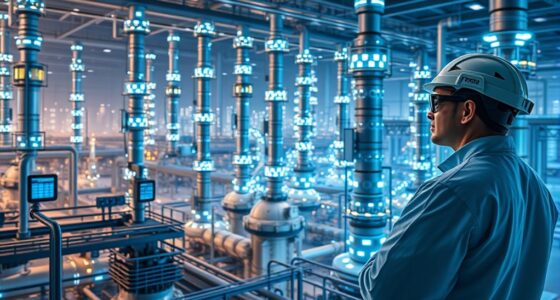To support a hydrogen economy, you need advanced materials for ammonia production, storage, and pipelines. You’ll require durable, lightweight containers and solid-state options like metal hydrides for safe storage, while pipeline materials must resist embrittlement and withstand long-term stresses. Safety standards and cost considerations play vital roles in material choices. If you keep exploring, you’ll discover how innovative materials are shaping a reliable and efficient hydrogen infrastructure for the future.
Key Takeaways
- Materials for ammonia synthesis and handling require corrosion-resistant, high-strength alloys to manage reactive and toxic properties.
- Effective hydrogen storage demands lightweight, durable materials like metal hydrides or composite tanks to ensure safety and efficiency.
- Pipeline materials must resist hydrogen embrittlement and degradation to ensure long-term, safe hydrogen transportation.
- Safety standards and protective coatings are essential for materials used in storage and pipelines to prevent leaks and environmental hazards.
- Cost-effective, scalable materials are critical for expanding hydrogen infrastructure, balancing durability, safety, and economic viability.

As the world shifts toward cleaner energy sources, hydrogen has emerged as a promising alternative for reducing carbon emissions. However, accessing its full potential requires robust materials and infrastructure to store and transport it efficiently. One of your primary concerns will be hydrogen storage. Unlike traditional fuels, hydrogen is a tiny molecule that easily escapes containers, so you need specialized materials to keep it safely contained. High-pressure tanks made from composite materials are common, but advancing these to achieve higher storage densities remains critical. Solid-state storage options, such as metal hydrides, are also under development, offering safer and more compact solutions, but they still face challenges related to weight and cost. Ensuring that storage materials are durable, lightweight, and capable of handling extreme conditions will be essential as you scale up hydrogen use. Material durability plays a crucial role in determining the long-term viability of storage solutions.
Simultaneously, developing reliable pipeline infrastructure is essential for transporting hydrogen over long distances. You’ll need materials that resist embrittlement—a phenomenon where hydrogen makes metals brittle—so pipelines don’t crack or fail. Traditional pipeline steels can be susceptible, prompting research into alternative alloys or coatings that prevent degradation. Building a network of pipelines will require not only resilient materials but also standards and safety protocols to manage leaks and minimize environmental impact. As you expand pipeline infrastructure, consider how materials can facilitate seamless integration with existing natural gas networks or serve as dedicated routes for hydrogen. The compatibility of pipeline materials with various hydrogen qualities, such as different purity levels or the presence of impurities, will influence the efficiency and safety of the entire system.
Moreover, the economic and logistical aspects of material selection also matter. Cheaper, readily available materials can help accelerate deployment, but they must meet safety standards. Innovations in pipeline materials and storage technologies need to balance cost, durability, and safety. You’ll also have to think about maintenance and lifespan—materials must withstand years of operation without significant degradation. As you plan for widespread hydrogen adoption, investments in advanced materials for storage and pipelines will be essential. These components will serve as the backbone of a hydrogen economy, ensuring that hydrogen remains a safe, efficient, and scalable energy carrier. Success hinges on your ability to develop and deploy materials that can handle the unique demands of hydrogen, making it a practical choice for a cleaner future.
Frequently Asked Questions
What Are the Safety Concerns With Hydrogen Storage?
You should be aware that hydrogen storage poses safety concerns like potential leakages, which can lead to fire hazards. Maintaining storage tank integrity is vital to prevent leaks and structural failures. Hydrogen’s small molecules easily escape through tiny openings, increasing risks. Always guarantee proper ventilation, regular inspections, and leak detection systems are in place to minimize dangers and keep storage facilities safe.
How Cost-Effective Are Ammonia-Based Hydrogen Production Methods?
You’ll love how ammonia-based hydrogen production can be surprisingly cost-effective—if you ignore the hefty energy inputs and complex synthesis processes. By improving ammonia synthesis and focusing on cost reduction strategies, experts aim to make this method more affordable. While it’s not quite cheap enough to replace traditional methods yet, ongoing innovations could turn ammonia into a more economical and practical hydrogen carrier, saving you from the expense of more traditional options.
What Materials Are Most Resistant to Hydrogen Embrittlement?
You should choose metal alloys like stainless steel or nickel-based alloys, which resist hydrogen embrittlement well. Applying advanced coating technologies, such as ceramic or polymer coatings, can further protect materials from hydrogen damage. These options help you maintain structural integrity in hydrogen environments, ensuring safety and longevity for pipelines and storage tanks. Regular maintenance and testing also play vital roles in preventing embrittlement-related failures.
How Do Pipeline Materials Impact Hydrogen Purity?
Think of pipeline materials like a gatekeeper, controlling hydrogen purity. If materials aren’t compatible, hydrogen can cause pipeline corrosion, leading to impurities in the gas flow. Poor material choices can introduce contaminants, reducing purity and increasing maintenance. Selecting corrosion-resistant materials guarantees the hydrogen stays clean, maintaining quality and safety. Your choice of pipeline material directly impacts hydrogen purity by preventing corrosion and maintaining the integrity of the gas transport system.
What Are the Environmental Impacts of Large-Scale Hydrogen Infrastructure?
You should consider that large-scale hydrogen infrastructure can impact the environment through land use, water consumption, and potential emissions if not managed properly. Integrating renewable energy sources reduces greenhouse gases, making the system cleaner. Additionally, focusing on infrastructure resilience ensures that hydrogen systems withstand environmental stresses, minimizing ecological disruption and enhancing safety. This approach helps balance the benefits of hydrogen with responsible environmental stewardship.
Conclusion
Think of the hydrogen economy as a mighty river, enthusiastic to flow but blocked by fragile dams and narrow channels. Your role is like an engineer, shaping the materials—ammonia, storage tanks, pipelines—that keep this river steady and safe. By choosing strong, innovative materials, you help channel this powerful current of clean energy toward a sustainable future. Together, you can build a resilient infrastructure that turns the promise of hydrogen into a thriving, unstoppable force.








